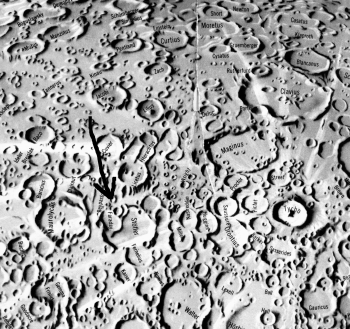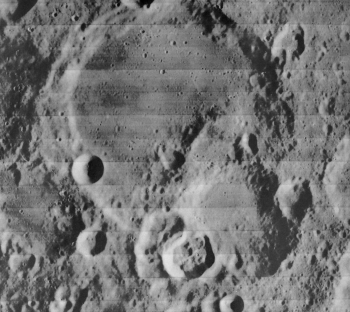

Neal Galt recently noted what sounds like a fairly dramatic sunrise ray in the lunar crater Stöfler. Incredibly, he was using a 36" telescope for this observation. Here are copies of the original e-mail reports:
Not sure if we have any lunar observers in the club, but in case we do,
I'm noticing an interesting beam (ray) in the crater Stöfler(with an
umlaut over the o). Using the Hatfield Photographic Lunar Atlas, Map
14 and 14A, it is located halfway between the craters F and K and
stretches halfway across the crater from the right to the left, and
starting at the crater wall connecting the two indicated smaller
craters. There are no high areas in the base of the crater at this
point, so I might assume a reflection, or a rare hole which allows the
light through.
For those that are interested and read this before the moon
sets....let me know what you think. Neal
>>>>
There is also a second ray or lighting spike above the main one, much closer to crater F. Since Stöfler is next to the terminator the crater base is pitch black, so the contrast for seeing the beams is excellent. I suspect this may be a gradual lighting of the base of the crater, even though it appears flat in this area. Other craters along the terminator, with equally dark bases and jagged rims are now showing this same event. Neal>>>>
My first observation of it was at 9:15 PM (Arizona). That was the first and main ray. The second ray started appearing shortly after....9:30PM. Neal
Below are several months of predictions for this ray. Times are UT. The moon's altitude is valid only for Sierra Vista, Arizona. Because of the usual libration variables, I'd suggest looking up to an hour either side of these times. YYYY MM DD Hr Mn Solar_Lat Moon_Alt 2002 01 20 09 35 -0.9 -38.3 2002 02 18 22 39 -1.4 +61.0 2002 03 20 11 43 -1.5 -37.5 2002 04 19 00 47 -1.2 +81.0 2002 05 18 13 51 -0.6 -34.4 2002 06 17 02 55 +0.2 +53.7 2002 07 16 15 59 +0.9 -37.9 2002 08 15 05 03 +1.4 +14.0 2002 09 13 18 08 +1.5 -25.7 2002 10 13 07 12 +1.2 -10.9 2002 11 11 20 16 +0.6 -1.0 2002 12 11 09 20 -0.3 -31.2 2003 01 09 22 24 -1.0 +42.5 2003 02 08 11 28 -1.5 -43.2 2003 03 10 00 32 -1.5 +79.5 2003 04 08 13 36 -1.1 -30.3 2003 05 08 02 40 -0.4 +60.7 2003 06 06 15 44 +0.4 -25.4 2003 07 06 04 48 +1.1 +25.6
Crater Description:
Stofler, +075,-655. A large mountain-walled depression disturbed on the west by the intrusion of Faraday. The remaining walls are very rugged and most symmetrical on the east, where the crest is thin and sharp. The inner slope here is broad with evidences of landslips. On the south wall is a deep crater, F, the interior which is level. Under a high sun the floor is very level, and crossed by rays from Tycho; and it is noteworthy for some dark spots, similar to those within Alphonsus and Grimaldi. The largest is of triangular shape, the base lying along the inner east slope. A row of minute objects, probably craterpits, traverses this from north to south. South-west is a smaller patch with a pit on its north edge. A long dark streak runs north-west along the south slope of a large landswell, dotted with craterlets which also exist on the south. Three are very bright, and there are also some very shallow bowl-like depressions. A chain of these occupies the north-west, but is only visible in large instruments. Beyond the west slope rises to Faraday, against the east wall of which is a large irregular depression with some smaller ones on the north and south. On the south-east outer slope are two large, almost square depressions, with rows of confluent craters on their east borders. J.Cooke has measured the east wall, and finds peaks ranging from 8000 to 12000 feet in altitude. - Wilkins and Moore, The Moon, Faber and Faber Ltd., 1955

